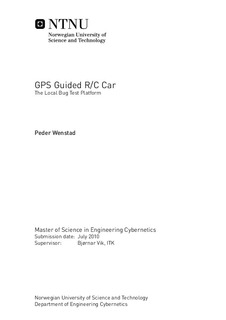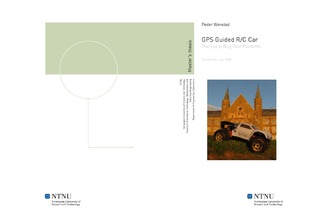| dc.contributor.advisor | Vik, Bjørnar | nb_NO |
| dc.contributor.author | Wenstad, Peder | nb_NO |
| dc.date.accessioned | 2014-12-19T14:03:15Z | |
| dc.date.available | 2014-12-19T14:03:15Z | |
| dc.date.created | 2010-10-13 | nb_NO |
| dc.date.issued | 2010 | nb_NO |
| dc.identifier | 356729 | nb_NO |
| dc.identifier | ntnudaim:5407 | nb_NO |
| dc.identifier.uri | http://hdl.handle.net/11250/260229 | |
| dc.description.abstract | This thesis is a part of the Local Hawk student project where the overall goal is to develop a Autonomous Unmanned Aerial Vehicle (AUAV). The project was initiated by Kongsberg Defence Systems (KDS) and is developed in collaboration with the Norwegian University of Science and Technology (NTNU). In an AUAV it is necessary to have a guidance system in order to be autonomous. To be able to test guidance principles in practice without risking the Local Hawk airframe the need of a ground based test platform became apparent. This thesis is the development of the Local Bug Test Platform.The Local Bug is based on a R/C car and utilizes electronics used and developed in the Local Hawk project. In order to understand the system behaviour, vehicle modelling is discussed and two models are presented. One of them is used in a SIMULINK simulator design for the Local Bug. The simulator is used to ensure the correct controller behaviour before it is tested on the real system. Phoenix II is the backbone of the Local Bug electronics and is used to gather measurement data, log data to memory and execute controller algorithms. Custom made C-code is used as a framework providing all the functionality needed. A introduction to Real-Time Workshop is given, and a step-by-step guide on how to use RTW generated C-code on the Phoenix II for controller purposes.A heading controller is designed and used in combination to two different guidance algorithms. The Line of Sight algorithm aims for the next waypoint regardless where the vehicle is positioned relative other waypoints. A Cross-Track Error algorithm with look ahead distance functionality focuses on minimizing the vehicles distance from a desired path. Both algorithms successfully guides the vehicle trough the test route visiting all the waypoints. The Local Bug is now usable as a test platform for controller algorithms. Measurements are logged to memory making it possible to analyse the performance after a test has been conducted. The overall functionality is found to be satisfactory and the Local Hawk project now has its desired controller/guidance test platform. | nb_NO |
| dc.language | eng | nb_NO |
| dc.publisher | Institutt for teknisk kybernetikk | nb_NO |
| dc.subject | ntnudaim:5407 | no_NO |
| dc.subject | SIE3 teknisk kybernetikk | no_NO |
| dc.subject | Reguleringsteknikk | no_NO |
| dc.title | GPS Guided R/C Car: The Local Bug Test Platform | nb_NO |
| dc.type | Master thesis | nb_NO |
| dc.source.pagenumber | 88 | nb_NO |
| dc.contributor.department | Norges teknisk-naturvitenskapelige universitet, Fakultet for informasjonsteknologi, matematikk og elektroteknikk, Institutt for teknisk kybernetikk | nb_NO |

